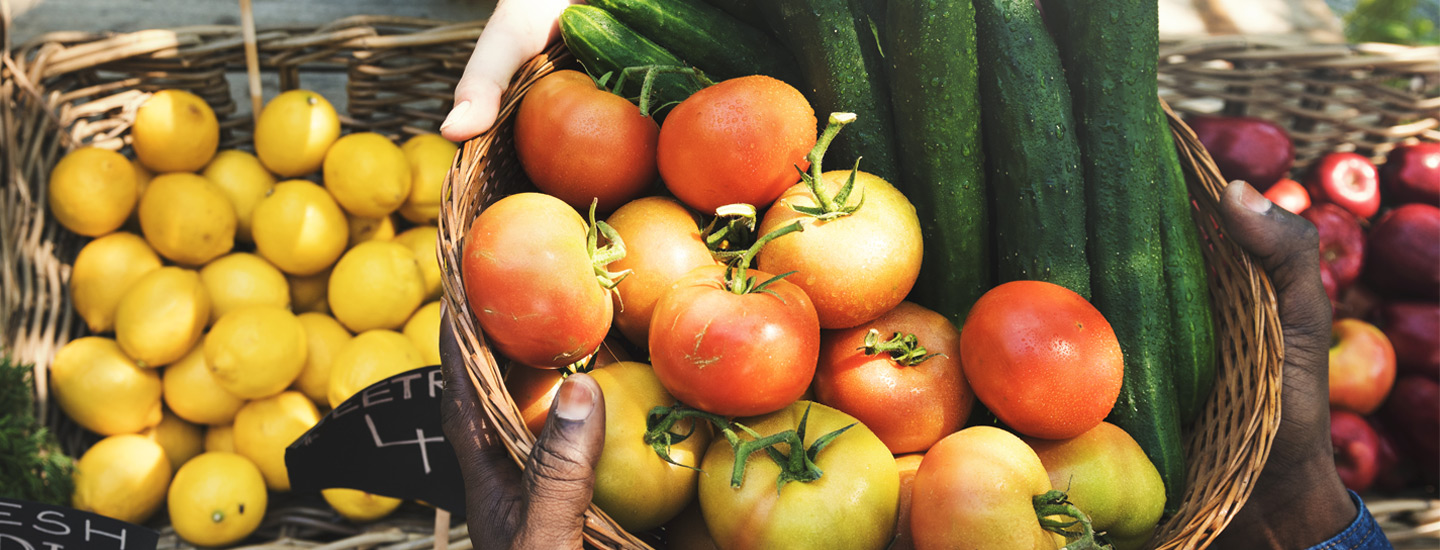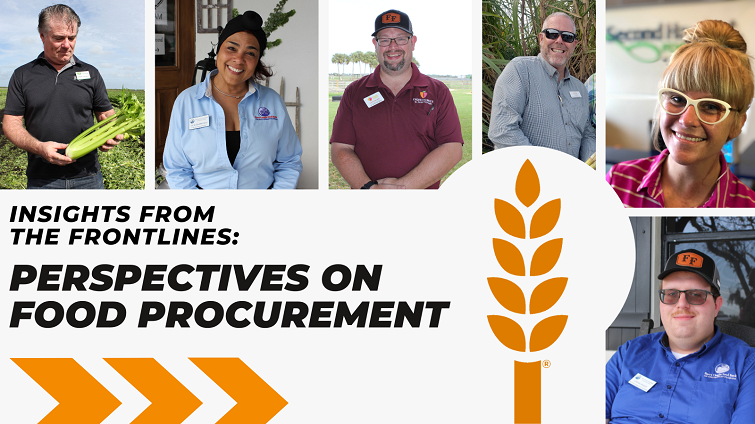In the battle against food insecurity, the Feeding Florida food bank staff working in food procurement play a critical role. From handling perishable items to forging partnerships with local businesses and farmers, every aspect of the food banks’ procurement process is vital in ensuring that communities have access to nutritious food.
In this blog post, we'll hear from some of our food bank procurement teams as they share their perspectives on food sourcing.
Michael Thompson, Treasure Coast Food Bank
Question: How does a food bank procure food? What are all the different sources you get food from?
Answer:
We obtain donations from all aspects of local retail business, manufacturing and agriculture as well as grass roots type of support such as community food drives and events.
Financial funding through donations plays a huge role, but aside from that channel, it's a combined effort of awareness, urgency, care and trust. Donors, whether current or potential, want reassurance that we as a partner will always demonstrate all of these characteristics. With that in place, donors want to give and support our causes.
Ken Gilbert, Feeding Northeast Florida
Question: How do you handle perishable food items and ensure they reach those in need before expiration?
Answer:
We are dedicated to carefully overseeing products to ensure we provide the highest quality items. We use the “first in first out” method and are focused on sending out products before expiration and with enough shelf life to be consumed. We must adapt and adjust sometimes because we have many avenues of how products are received – purchased, donated, distribution centers, farms etc.
The best help we could receive from donors and retailers is to make sure that product they donate is wholesome and can withstand time to be given to our guest and be able to be consumed and not discarded.
Question: Can you provide examples of successful partnerships that have enhanced your food procurement capabilities?
Answer:
We have built partnerships on both sides of sourcing and distribution- retail and farms on one side and agencies on the other- that helps our capabilities. Approximately 70% of food donations come from retail operations (retail stores and distribution centers), with 250 retail stores within our footprint contributing. Thanks to relationships with local farms, there are times when we purchase from them and there are times when they donate, which also helps our operation.
Agencies are the outlet for our food to serve our neighbors and they help us with operations. If we are heavy on a product, the agency also is an avenue to help move that item into the community more quickly. In this way, a food bank is a living business that continuously changes.
Chuck Wolbert, All Faiths Food Bank
Question: How do you ensure the quality and safety of donated food items?
Answer:
First and foremost, we ensure proper time and temperature logs are provided or utilized by our donation partners. This ensures that we are receiving product that has not been time and temperature abused prior to being received at the food bank. Visiting donors on a consistent basis allows us to see how the product is harvested or produced, and that we are receiving product handled in a safe manner.
Question: Does your job role change based on the time of year? Do you only get certain things during certain times of the year?
Answer:
My role changes by the minute. There are so many hats that many of us have to wear from Food Procurement to Warehouse, even more so in Disaster Response. During disaster response, all members of a food bank goes through a change in roles – it becomes “all hands on deck” to ensure that our neighbors are taken care of.
When sourcing items, seasonality plays a factor in everything we get. Distributing pumpkin or cranberry sauce does not make as much sense in April as it does in November. What many do not realize is the planning that goes into food procurement. At All Faiths Food Bank, we began our Thanksgiving distribution planning in January and placed orders for most of our products in March.
Kristen White, Second Harvest Food Bank of Central Florida
Question: Are there any specific types of food items that are in high demand or that you find particularly challenging to procure?
Answer:
We are laser focused on increasing the amount of healthy foods we distribute. Our network of community partners consistently share that our neighbors are filled with so much hope when they receive fresh fruits and vegetables, healthy proteins, dairy, and juices, along with their other pantry staples.
Question: How do you collaborate with local businesses, farmers, and other partners to secure donations?
Answer:
Collaboration with food businesses, farmers, and trade groups starts with investing time spent learning about their operations, their unique challenges, business needs or goals, and developing donation programs that are a good fit for our community. This is one of my favorite parts of my job because I find so much joy in learning from our donors, getting to see first-hand how our food is produced, and developing lasting relationships.
Examples of Second Harvest collaborations include:
- Vital donation partnerships with over 500 retail locations rescuing over 25 million meals each year
- Development of Disney World’s ‘Disney Harvest’ Program that in 2023 diverted 380,000 pounds of food from Disney World Resort Kitchens to our community feeding partners
- Work with our local farmers, agriculture system, and gleaning partners to develop donation and purchasing partnerships that ensure our farmers are ‘made whole’ and our food bank can provide our network of over 450 partners agencies with a consistent variety of fresh fruits, vegetables, dairy, and proteins year-round
We have so many more exciting examples of collaboration, all because of the incredible generosity of our community.
Julie Mercado and Jordan Knisley, Harry Chapin Food Bank of Southwest Florida
Question: Can you provide examples of successful partnerships that have enhanced your food procurement capabilities?
Answer:
- YoGusto- Milk, Dairy, and Yogurt: This dairy supplier Clewiston, along with their partner Milking R Dairy in Okeechobee, has facilitated connections and provided substantial donations. From the beginning, YoGusto’s team has recognized our need, understood our mission, and are willing to supply our demand to meet our goals. They immediately started connecting us with other companies that would support our mission as well. We received a full truckload of coconut water from a partner company, a connection made by YoGusto and they also donate product to us regularly with their monthly shipments.
- FM Meats & Perry Cattle Farms- Ground Beef: Since September 2023, 30,000 pounds of ground beef have been purchased monthly from FM Meats, supporting local ranchers. Perry Cattle Farms contributes live cattle, enhancing local sourcing. The future plan is to source all of the cattle that FM Meats harvests for us with local ranchers we interact with, who understand our mission and are willing to donate a portion of the cattle on a monthly basis.
- Government Agencies Relations: Connections through UF/IFAS offices in Hendry and Collier County have been instrumental in finding local ranchers. We have met great people who have graciously provided valuable information on these local contacts without hesitation.
- Florida Freezer- Storage: This third-party storage partner has enabled efficient storage and distribution for temperature-controlled commodities. Through them we have managed to store and distribute to the community over 60% of our purchased products without them ever reaching our main warehouse successfully and remotely. We have also received donations, such as a 36-pallet frozen pastry donation they transported from Miami and stored without cost for a full month while we distributed it.
- Network Resources: Mentorship and opportunities from individuals such as Cacee Hillard of Feeding Florida and Jerod Matthews of Feeding America have been invaluable.
Question: How do our food banks prioritize diversity and nutritional value when procuring food for distribution?
Answer:
We follow Healthy Eating Research (HER) Guidelines, ensuring low or no salt/sugar, low or no fat products, staying within green and yellow colors. LFPA grant funding focuses on disadvantaged farmers and producers, requiring local purchases from these identified groups. We also include commodities like rice, beans, crema, and lactose-free milk that are welcomed by the community we serve.
The insights and experiences shared by Ken, Kristen, Chuck, Michael, Julie and Jordan offer a glimpse into the complex yet vital world of food procurement. Through collaborative efforts, innovative initiatives, and unwavering dedication, these professionals are making significant strides in the fight against food insecurity.


